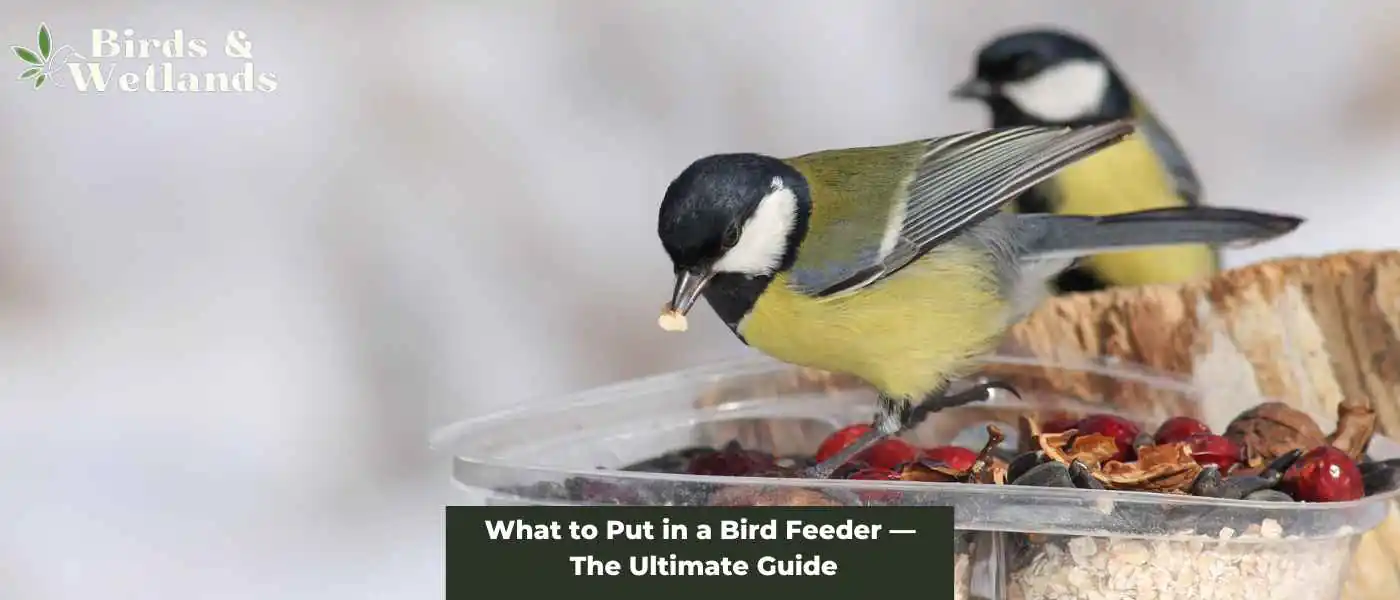One of the best ways to attract birds to your yard is by setting up a bird feeder. However, with so many different bird feeders and birdseed types available, it can be overwhelming to know where to start. That’s why we’ve put together the ultimate guide on what to put in bird feeders.
In this blog, we’ll provide you with everything you need to know to attract various wild birds to your yard and keep them coming back for more. So, grab your binoculars and let’s get started!
Key Takeaways On What To Feed Birds
Things to Consider
- Bird Species in Your Area: Different species of birds have different dietary preferences. Do some research or observation to identify what birds are common in your area and what they like to eat.
- Time of Year: Different foods may be more appropriate at different times of the year. For example, high-fat foods like suet can be particularly beneficial in the winter months, while fresh fruit and nectar can attract birds in the summer.
- Bird Feeder Type: The type of feeder you have can determine what kind of food you can put out. Some feeders are designed for specific types of food, such as tube feeders for small seeds, suet feeders for suet blocks, or hummingbird feeders for nectar.
- Avoiding Pests: Some types of bird food can attract pests like rodents or unwanted bird species. If this is an issue in your area, you might want to choose your bird food accordingly. For example, safflower seeds are typically unappealing to squirrels, and nyjer seeds can deter larger, more aggressive birds.
- Nutritional Value: Birds need a balanced diet just like we do. Try to provide a mix of seeds, fruits, fats, and insects to offer a range of nutrients. Avoid foods that can be harmful to birds, such as anything with high salt or sugar content, or moldy or spoiled food.
- Cost and Availability: Some types of bird food can be more expensive or harder to find than others. Consider what types of bird food fit within your budget and are readily available in your area.
- Mess and Waste: Some types of bird food can create more mess or waste than others. For example, sunflower seeds in the shell can result in a lot of discarded hulls beneath the feeder. You might prefer to choose hulled sunflower seeds or other types of seed to reduce mess. Also cheaper bird mixes are filled with cheap filler birds won’t eat.
What To Put in Feeder
What you put in your bird feeder depends on the types of birds you’re hoping to attract. Different species have different dietary preferences. Here are some popular choices:
Seeds
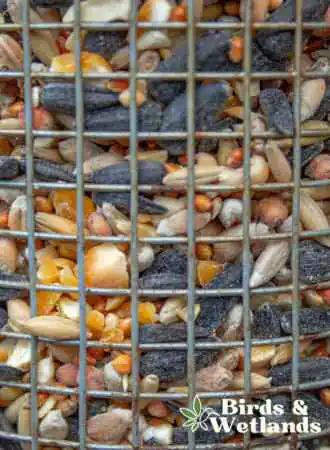
Sunflower seeds are the edible seeds with thin shells of the sunflower plant, Helianthus annuus. They are oval-shaped and covered by a black-and-white striped outer shell. Black oil sunflower seed is the most popular kind of these seeds.
Birds, including finches, cardinals, chickadees, nuthatches, jays, and woodpeckers, are particularly fond of these seeds, a common ingredient in birdseed mixes. And birds are crazy for them for a variety of reasons.
Black oil sunflower seeds are a rich source of protein, fat, and fiber, making them a nutritious food source for birds. Protein is essential for building and repairing tissues, while fat provides birds the energy they need to fly and maintain their body temperature. Fiber helps birds digest their food and absorb nutrients.
The shells of sunflower seeds are thin and relatively easy for birds to crack open. This means that birds can quickly access the nutritious seed inside.
Sunflower seeds are offered to birds in a variety of ways. They can be left in a bird feeder or scattered on the ground. You can use pole-mounted feeders or hopper feeders. They can also come with their shells on or hulled. You can even mix them with other bird foods such as cracked corn or dried fruit. This versatility makes sunflower seeds a popular choice for backyard bird feeders.
Black Oil Sunflower Seed
- High Nutrient Content: The Blue Seal Premium Black Oil Sunflower Wild Bird Seed is high in fat and protein, providing essential nutrients to wild birds especially during harsh winter months.
- Attracts Diverse Species: The seeds are known to attract a wide variety of wild birds, such as Northern Cardinals, Tufted Titmice, Mourning Doves, and Evening Grosbeaks, thereby enhancing your bird-watching experience.
- Increased Survival Rates: The presence of these bird seeds in your feeder can increase bird survival rates by up to 38%, contributing to the conservation of local bird populations.
- Promotes Overall Health: Offering a consistent and reliable source of feed like this can lead to less stress and greater overall health in the bird population visiting your garden.
Nyjer seeds
Nyjer seeds, also known as thistle seeds, are small, oil-rich seeds from the African yellow daisy. They are commonly used as birdseed, especially for finches, sparrows, and other birds. The high oil content of nyjer seeds makes them an excellent source of energy for small birds, especially during cold winter months when food is scarce.
Birds love these seeds because of their small size, which makes them easy to handle and eat. Nyjer seeds have a tough outer shell, which helps to keep them fresh and reduces the risk of spoilage. They are a popular food for a tube feeder.
Safflower seeds
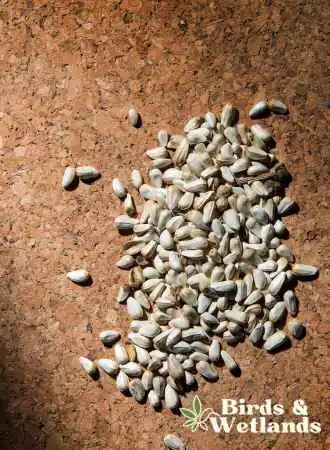
Safflower seeds are another type of birdseed popular among backyard bird enthusiasts. They are derived from the safflower plant, a thistle-like plant native to the Middle East.
Safflower seeds are high in fat and protein, making them an excellent source of nutrition for many birds, including finches, cardinals, doves and other species of birds.
One of the advantages of safflower seeds is that many birds eat them but they are not as attractive to squirrels and other rodents as some different types of bird seed, which can help to reduce waste and save money.
Safflower seeds have a hard outer shell that helps to keep them fresh and reduces the risk of spoilage. Finally, some birders prefer safflower seeds because they are less likely to attract unwanted birds, such as starlings and grackles, which can be aggressive and territorial around feeders.
Safflower Seed
- Squirrel Deterrent: The safflower seeds are bitter to squirrels, serving as a natural deterrent, and thus focus solely on attracting a variety of birds to your garden.
- High Nutritional Value: Rich in fats and proteins, these seeds provide the essential energy and nutrition that backyard birds require, enhancing their overall health and vitality.
- Clean and Healthy: The triple-cleaning process ensures dust and debris are removed before packaging, offering a clean and healthy food source to your feathered friends.
- Pleasant Aroma: The seeds not only look good but also have a fresh and pleasant smell, making them an even more appealing snack for birds.
Millet
Millet is a type of small, round seed commonly used as birdseed. It has several varieties, including white proso, red, and golden millet.
Millet is an excellent source of nutrition for birds, as it is high in protein, fiber, and essential minerals such as magnesium and phosphorus. It is especially popular among ground-feeding birds such as doves, house sparrows, and towhees, as well as some types of finches.
One of the benefits of millet is that it is relatively inexpensive compared to other types of bird seed, making it a popular choice for backyard bird feeding. Millet is also versatile and can be used in different feeders, including tube feeders, tray feeders, platform feeders, and ground feeders.
Millet and other seeds is easy to store and has a long shelf life, making it a convenient option for birders who want to keep their feeders stocked with fresh seed mixes for attracting more birds.
Nuts
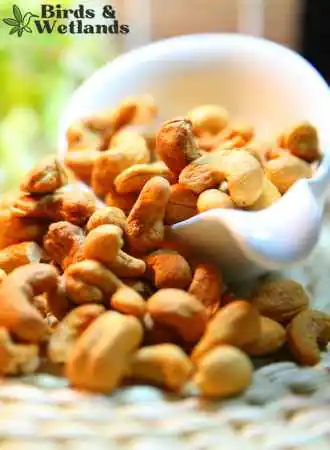
Nuts can provide birds with essential nutrients and calories to help them survive during harsh weather conditions or when food sources are scarce.
Here are some of the most popular nuts to feed birds with.
Peanuts
Peanuts are a type of legume that grows underground and are rich in protein, fiber, and healthy fats. Many bird species, such as blue jays, woodpeckers, and nuthatches, enjoy peanuts as a part of their diet.
The high-fat content of peanuts provides birds with a quick and easy energy source, especially in cold weather when food can be scarce.
Peanuts are also a popular food for birds that store food for later, as they are easy to carry and store. The shells of peanuts can provide birds with nesting material and be used to line their nests.
Almonds

Almonds are a type of tree nut native to the Middle East and South Asia but are now widely cultivated in California and other parts of the world.
Birds are attracted to almonds because of their high fat and protein content, which provides them with energy and helps them stay warm in cold weather. They are also a good source of fiber and various vitamins and minerals, such as vitamin E and magnesium.
Squirrels and chipmunks are also attracted to almonds, so you need to take measures to deter these animals from feasting on the almonds of your bird feeders. For instance, you can use a squirrel-proof feeder with a weight-sensitive perch that closes when a heavier animal or larger birds lands on it, only allowing smaller birds access.
Walnuts
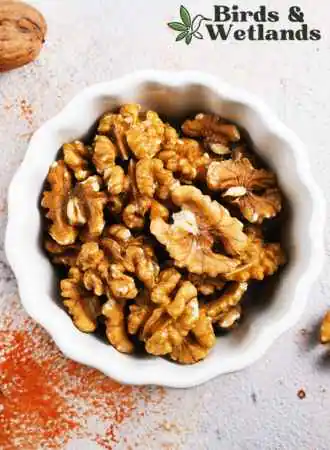
Walnuts are a type of tree nut rich in healthy fats, protein, fiber, and various vitamins and minerals such as vitamin E and magnesium. Many bird species, such as blue jays, crows, and woodpeckers, widely consume them. The high-fat content of walnuts makes them an attractive food source for birds and other animals, especially during the winter or early spring when food can scarce.
Walnuts can also be used as nesting material for birds, and their shells can be used as mulch or compost for plants.
Sugar Water

Nectar feeders or hummingbird feeders are filled with a solution of sugar water, which mimics the nectar found in flowers that hummingbirds feed on. To make the solution, mix four parts water with one part of granulated white sugar. For example, mix 1 cup of sugar with 4 cups of water.
It is important to use granulated white sugar, as other sweeteners such as honey, brown sugar, red food coloring, or artificial sweeteners can harm hummingbirds.
Boiling the mixture for a few minutes can help prevent fermentation and spoilage, but let it cool completely before filling your feeder. Changing the nectar every three to five days is recommended, or more frequently in hot weather, to prevent spoilage and bacterial growth. Clean the feeder thoroughly with hot water and soap between refills.
Suet
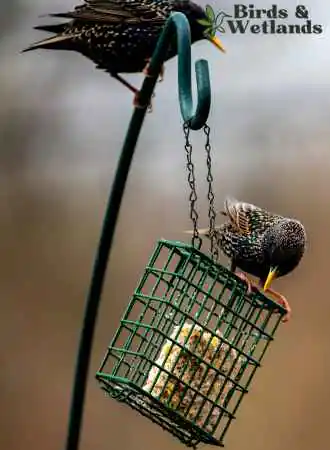
Suet is a type of high-energy bird food made from animal fat, typically beef or mutton. It is a popular choice for bird feeding because it is nutritious and attracts many backyard birds.
Suet is especially beneficial for most birds during winter when their food sources are limited. The high-fat content in suet provides birds with a concentrated source of energy, which helps them to maintain their body temperature and survive the cold weather.
Suet is a popular choice for attracting birds such as woodpeckers, nuthatches, chickadees, and other insect-eating birds. A variety of birds are attracted to the high protein and fat content in suet, similar to the insects they would normally feed on in the wild.
You can use a variety of other feeders when it comes to feeding birds suet. Suet feeders typically consist of a wire cage or mesh bag that can hold the suet block or ball. These feeders are designed to allow birds to cling onto the mesh or cage and peck at the suet from different angles. Some suet feeders are also designed with a tail prop to support woodpeckers and other clinging birds.
It is important to note that suet can melt in warm weather, so it is best to place the feeder in a shaded area during the summer months. Alternatively, provide suet only during cool weather. Suet should also be replaced regularly to prevent it from spoiling and potentially making birds sick.
Wild Bird Copper Suet Feeder
A Must-Have for Bird Lovers
- Triple Capacity: Hold up to 3 cakes or a large brick for continuous bird feeding.
- User-Friendly: The EZ Fill design ensures effortless reloading of bird feed.
- Weather-Proof: Its unique roof design keeps feed dry, ensuring birds can feast in any weather.
- Comfort-First Design: The vinyl coating prevents birds’ feet from freezing in winter or burning in summer.
Additional Tips
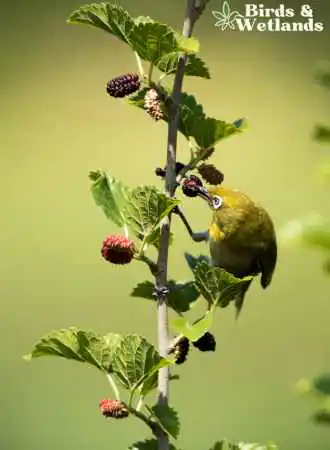
- Responsible cat owners wanting to attract orioles and other winter birds should keep their cats indoors. Every year, cats kill hundreds of millions of birds and local wildlife worldwide.
- Use squirrel proof feeders and squirrel baffles to deter squirrels and other rodents from raiding your birds feeders.
- Clean feeders regularly to before they become a breeding ground of mold, bacteria and germs.
- Placing feeders in the right spots, especially if you have more than one feeder, can help avoid crowding.
- Keep the seed dry at all times, otherwise it will spoil quickly.
- Place feeders in a sheltered place or near shrubs and plants with thick foliage.
- Besides seeds and nuts, provide fruit for fruit-eating birds.
- Choose a bird feeder with drainage holes to prevent water accumulation.

